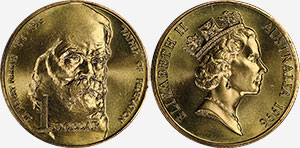1 dollar 1996 - Sir Henry Parkes
By CAA | Tuesday, 16 January 2024
This circulating coin was issued to commemorate the centenary of the Constitutional Conventions that led to Federation and the role of Sir Henry Parkes, widely acknowledged as the Father of Federation.
The reverse, like the 1 dollar 1997 - Charles Kingsford Smith one, was designed and sculpted by Wojciech Pietranik. Instead of the regular kangaroos, it features a portrait of Parkes.
Sir Henry Parkes was described during his lifetime by The Times of London as the most commanding figure in Australian politics.
Born in Warwickshire, England, Sir Henry Parkes (1815–1896) was a political survivor, evidenced by the fact that he was premier of colonial New South Wales five times between 1872 and 1891. His political life spanned the second half of the 19th century, from the establishment of responsible self government in 1856, through the era of faction politics characterised by shifting alliances, to the advent of the party system.
Sir Henry Parkes (1815-1896), imposing in stature and a fiery orator, is a central figure in the history of Australian politics. Although he died five years before Federation in 1900, Parkes was one of the most vigorous and eloquent advocates for the Commonwealth of Australia.
From his arrival in Sydney from England in 1839 with his first wife Clarinda, he campaigned for constitutional reform, for the 'freedom and independence' of his adopted land. His persuasive talents for organising earned him one of the first seats in the new NSW Legislative Assembly of 1856, and he was in and out of politics and power for the rest of his life, including 5 terms as premier.
In the pages of "The Empire", the newspaper he founded in 1850, Sir Henry Parkes established his reputation as an energetic defender of liberalism, with a progressive belief in the importance of education.
His rocky commercial fortunes and his ambitious pursuit of personal goals led to criticism during his stormy career, but Parkes' speech at Tenterfield in 1889, calling for a 'great national Government for all Australia', was a moment when the strength and commitment of political will was crystallised, providing the focus for a new in Australia's history.
- Royal Australian Mint
5 dollar 2011 banknotes
In celebration of the Centenary of Australia's Federation, the Reserve Bank of Australia issued a commemorative $5 banknote in January 2001 with Parkes on it.
1 dollar 1996 specifications
- Mintage: 26,200,200 (circulation)
- Composition: Aluminum bronze (92% Copper, 6% Aluminium, 2% Nickel)
- Weight: 9 g
- Diameter: 25.12 mm
- Thickness: 2.5 mm
- Die axis: ↑↑
Henry Parkes Facts
1815
Born in Warwickshire, England, in 1815, Parkes became a bone and ivory turner.
1839
He emigrated to New South Wales and drifted into journalism after fitful progress in his trade. His literary and political writings belied his lack of formal education. While in England he had taken up the cause of political radicalism, an interest he continued in the colony.
1848
He campaigned for universal male suffrage and played a prominent role in the campaign against the resumption of convict transportation to New South Wales.
1850–1858
He was editor and proprietor of The Empire newspaper, an organ of liberal opinion.
1854
Parkes won a seat in the Legislative Council at the elections of 1854.
1856
He was elected to the newly established Legislative Assembly in the first Parliament under responsible self government.
1877
He was knighted in 1877.
1880
Parkes' legislative and secular reforms in education, particularly the 1880 Public Instruction Act, which strengthened the state education system, were controversial and aroused sectarian discord.
1887
In anticipation of the forthcoming Centennial celebrations, Parkes unsuccessfully sought to have New South Wales renamed Australia.
1889
On 24 October 1889, at a reception in his honour at the Tenterfield School of Arts, Parkes delivered an address to his former constituents that was a clarion call for Federation. In this landmark speech he declared that the time was right for a convention of representatives from all the colonies to be convened 'to devise the constitution which would be necessary for bringing into existence a federal government with a federal parliament for the conduct of national undertaking'.
1890
Parkes convened the 1890 Federation Conference in Melbourne as a precursor to the 1891 National Australasian Convention in Sydney.
1891
The 1891 National Australasian Convention in Sydney is where the first draft Bill of the Constitution was written. It was also there that he proposed the name ‘Commonwealth’ for the unified colonies.
1896
Parkes died at his home 'Kenilworth' in the Sydney suburb of Annandale on 27 April 1896, and was buried at Faulconbridge in the Blue Mountains. Married three times, his first and second wives had predeceased him. He was survived by his third wife, Julia, and numerous children from the marriages.
1901
One of Parkes' many legacies to the citizens of New South Wales was Centennial Park, a fitting site for the proclamation of the Commonwealth of Australia on 1 January 1901. Memorials to Sir Henry Parkes include the suburb of Parkes in Canberra, which is home to the Federal Parliament, and the central western New South Wales township of Parkes, both of which are named in his honour.
Uncirculated
The Mint allowed the public a chance to mint their own collector coins, like the 1 dollar 1997 - Charles Kingsford Smith. This involves the addition of a mint mark to the coin's reverse image.
The mint mark on these uncirculated coins can ben found on the upper-left of the reverse:
- Five Cents
- Ten Cents
- Twenty Cents
- Fifty Cents
- Sir Charles Kingsford Smith One Dollar
- Two Dollars
The Wojciech Pietranik design was also featured in proof (aluminum bronze and silver) and uncirculated sets.
1 dollar 1996 Price guide and values








